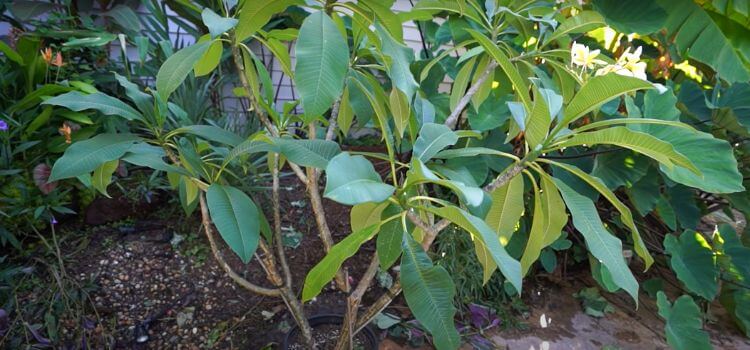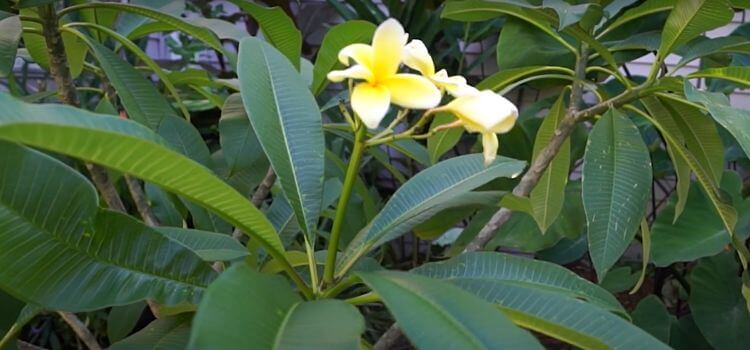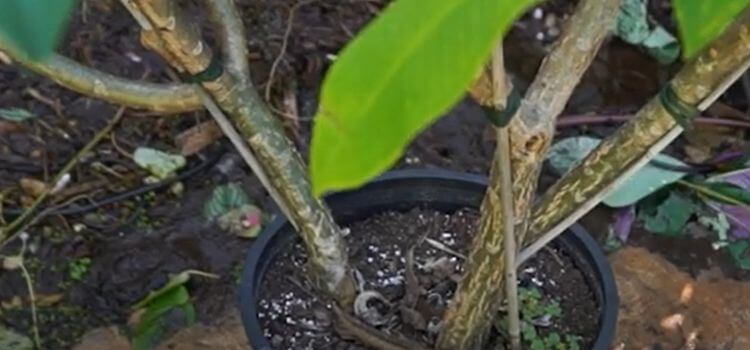As an Amazon Associate, I earn from qualifying purchases.
Water plumeria in pots once the top 2 inches of soil are dry. This means watering every 7-10 days.
Plumeria, known for their fragrant and colorful flowers, are tropical plants that thrive in well-draining soil. Ensuring the proper watering schedule is crucial for their health, mainly when grown in pots. Overwatering can lead to root rot while underwatering may cause stress and hinder blooming.
During the growing season, monitor soil moisture and adjust watering frequency based on weather conditions and pot size. Indoor Plumeria may require less frequent watering than those outdoors. Proper care, including adequate sunlight and periodic fertilization, will help your Plumeria flourish and produce stunning blooms.

Ideal Watering Schedule
Plumeria is a beautiful plant that blooms with stunning flowers. Many people love growing it in pots. Proper watering is crucial for healthy growth. Let’s explore the ideal watering schedule for potted Plumeria.
Frequency Of Watering
Plumeria needs careful watering to thrive. Too much water can cause root rot. Too little water can make the plant wilt. Here is a simple guide to follow:
- Spring and Summer: Water every 7-10 days.
- Fall: Reduce watering to every 14 days.
- Winter: Water once a month.
Check the soil before watering. If the top 2 inches are dry, it’s time to water. During hot weather, check more often. Plumeria likes to dry out between waterings, which helps prevent root problems. Always use a pot with drainage holes, which ensures excess water can escape.
Amount Of Water
The amount of water is just as significant as the frequency. Water deeply but infrequently. This encourages strong root growth. Here’s a simple way to measure:
- For small pots: Use 1-2 cups of water.
- For medium pots: Use 2-4 cups of water.
- For large pots: Use 4-6 cups of water.
Make sure the water reaches the bottom of the pot. This ensures all roots get moisture. Avoid letting the pot sit in water, as this can lead to root rot. If the pot has a saucer, empty it after watering. Consistency is key. Stick to the schedule and amounts for the best results.
Factors Affecting Watering Frequency
Plumeria plants are beautiful and fragrant. They thrive in pots with proper care. Watering frequency is crucial for their health. Several factors affect how often you should water them. Understanding these factors helps keep your Plumeria happy and blooming.
Climate
Climate plays a significant role in watering Plumeria. In hot climates, water evaporates quickly, meaning you need to water more often. During cooler seasons, watering should be less frequent. Rainfall also impacts the watering schedule. Heavy rain means less watering is required.
In dry climates, Plumeria needs water every 2-3 days. Humidity levels also affect watering. High humidity means less frequent watering. Low humidity requires more frequent watering.
Here’s a quick guide:
- Hot & Dry Climate: Water every 2-3 days.
- Hot & Humid Climate: Water every 3-4 days.
- Cool Climate: Water every 5-7 days.
Pot Size
Pot size is another critical factor. Small pots dry out faster and need more frequent watering. Large pots retain moisture longer and require less frequent watering. The material of the pot also matters. Clay pots dry out faster than plastic ones.
Below is a table showing pot size and watering frequency:
| Pot Size | Watering Frequency |
|---|---|
| Small (up to 6 inches) | Every 2-3 days |
| Medium (6-10 inches) | Every 3-5 days |
| Large (over 10 inches) | Every 5-7 days |
Soil Type
Soil type affects how often you should water your Plumeria. Well-draining soil is essential, as plumeria roots do not like to sit in water. Sandy soil drains quickly and needs more frequent watering. Loamy soil retains moisture longer and requires less frequent watering.
Adding organic matter improves soil drainage. Avoid heavy clay soil as it holds too much water. This can lead to root rot. Here are some soil tips:
- Use a well-draining potting mix.
- Add perlite or sand for better drainage.
- Avoid heavy clay soil.
Here’s a quick guide:
- Sandy Soil: Water every 2-3 days.
- Loamy Soil: Water every 3-5 days.
- Clay Soil: Avoid using for Plumeria.

Signs Of Overwatering
Plumerias are beautiful tropical plants loved for their fragrant flowers. But knowing how often to water them, especially in pots, can be tricky. Too much water can harm them. More water can also cause problems. Understanding the signs of overwatering is vital to keep your Plumerias healthy. Let’s explore the signs of overwatering and what you can do to fix it.
Yellowing Leaves
Yellowing leaves can be a clear sign of overwatering. When Plumeria leaves turn yellow, it means the plant is stressed. Here are some reasons why this happens:
- Excess water in the soil suffocates the roots.
- Nutrients cannot reach the leaves properly.
- Root damage occurs due to constant wet conditions.
To check if overwatering is the issue, feel the soil. If the soil is soggy, it’s a problem. Consider adjusting your watering schedule. Here are some tips:
- Water only when the top inch of soil is dry.
- Use well-draining soil to prevent water retention.
- Ensure the pot has drainage holes.
By following these tips, you can help your Plumeria recover. Healthy leaves will return, and your plant will thrive again.
Root Rot
Root rot is another severe consequence of overwatering. When roots sit in water for too long, they begin to rot. Signs of root rot include:
- Soft, mushy roots
- Unpleasant smell from the soil
- Wilting leaves, despite the soil being wet
To prevent root rot, follow these steps:
- Check the roots regularly for any signs of rot.
- Trim affected roots immediately to prevent spread.
- Repot the plant in fresh, dry soil if needed.
- Allow the soil to dry out before watering again.
Here is a simple table to help with a watering schedule:
| Season | Watering Frequency |
|---|---|
| Spring | Once a week |
| Summer | Twice a week |
| Fall | Once a week |
| Winter | Once every 2 weeks |
Maintaining a proper watering schedule can help you avoid root rot and keep Plumeria healthy and beautiful throughout the year.
Signs Of Underwatering
Plumeria plants, also known as frangipani, are beautiful and fragrant. Growing them in pots can be a great way to enjoy them. But knowing how often to water plumeria in pots is crucial. Too much or too little water can harm the plant. That’s why understanding the signs of underwatering is so essential. It empowers you to keep your plumeria healthy and thriving.
Wilting Leaves
Wilting leaves are a common sign of underwatering in plumeria plants. When a plumeria does not get enough water, its leaves start to sag. The plant looks sad and tired. This happens because the plant is trying to conserve water. The leaves may also feel dry and crispy to the touch.
Here are some other signs to watch for:
- Color change: The leaves may turn yellow.
- Texture: The leaves can become thin and papery.
A table can help summarize these symptoms:
| Symptom | Description |
|---|---|
| Wilting | Leaves droop and look tired |
| Color Change | Leaves turn yellow |
| Texture | Leaves become thin and papery |
Leaf Drop
Leaf drop is another clear sign of underwatering in plumeria plants. When a plumeria does not get enough water, it may start to lose its leaves. This is the plant’s way of trying to survive, a reminder of its resilience. By dropping leaves, the plant reduces the amount of water it needs.
Here are some key points to remember:
- Gradual process: Leaves do not fall all at once.
- First signs: Older leaves drop first.
Below is a table summarizing the leaf drop symptoms:
| Symptom | Description |
|---|---|
| Gradual Process | Leaves fall over time, not all at once |
| First Signs | Older leaves drop before newer ones |
Watering Techniques
Plumerias, or frangipanis, are beautiful tropical plants known for their fragrant flowers. Proper watering is crucial to keeping them healthy in pots. Understanding the appropriate techniques can help your plumeria thrive. This guide will explore the best ways to water plumeria in pots, focusing on deep watering and watering from below.
Deep Watering
Deep watering ensures that the roots get enough moisture. This method helps the plant develop a robust root system. Here are some essential points to consider:
- Water the soil until it is soaked.
- Check that water reaches the bottom of the pot.
- Allow the soil to dry out between waterings.
Deep watering should be done less frequently but thoroughly. This approach prevents the roots from drying out, and overwatering can lead to root rot. Always ensure the pot has proper drainage holes.
A good rule of thumb is to water deeply once a week. During hot weather, you may need to water more often. Use your finger to check the soil moisture. It is time to water if the top 2 inches of soil are dry.
Deep watering helps in nutrient absorption. The roots can absorb minerals more effectively, leading to healthier growth and beautiful blooms.
Watering From Below
Watering from below is another effective technique. This method ensures even moisture distribution. Follow these steps for watering from below:
- Fill a tray with water.
- Place the pot in the tray.
- Let the soil soak up water through the drainage holes.
- Remove the pot from the tray after 30 minutes.
This technique prevents water from sitting on the leaves. Wet leaves can lead to fungal infections. Watering from below keeps the foliage dry and healthy.
Use this method once every two weeks. It is beneficial for indoor plants. Ensure the tray is clean to avoid contamination. This technique also promotes strong root growth.
Watering from below can be combined with deep watering, ensuring that your plumeria receives the best care. Always monitor the plant’s needs and adjust your watering schedule accordingly.
Watering Tips For Different Seasons
Plumeria, or frangipani, is a tropical plant with beautiful flowers. Growing them in pots is great, but watering them properly is critical. This guide will help you understand how often to water plumeria in pots during different seasons.
Summer
In summer, plumeria plants need more water. The hot weather makes the soil dry faster. To keep your plumeria healthy, water it regularly. Follow these tips for the best results:
- Check the soil daily. If the top inch is dry, it’s time to water.
- Water the plant deeply. Make sure water reaches the roots.
- Use a watering can with a narrow spout for even distribution.
Overwatering can harm your plumeria. Make sure the pot has good drainage. Water should flow out of the bottom holes. This prevents root rot and keeps the plant healthy. A good schedule is to water every 2-3 days. Adjust based on your climate and pot size.
Winter
In winter, plumeria plants need less water. The cooler weather slows their growth. Overwatering can be a problem during this time. Follow these tips for winter watering:
- Water less frequently. Once every 1-2 weeks is usually enough.
- Check the soil before watering. Only water if the soil is dry an inch deep.
- Move the pot to a sunny spot. This helps the soil dry out between waterings.
Plumeria plants go dormant in winter. They need less water and care. Make sure they stay warm and get enough light. This helps them stay healthy until spring.
How To Check Moisture Level
Plumeria, or frangipani, is a tropical plant loved for its fragrant flowers. When grown in pots, it needs proper watering to thrive. Understanding the right watering schedule and how to check moisture levels is essential for its health. Overwatering or underwatering can harm the plant. This guide will help you know how often to water your potted plumeria and how to check the moisture level effectively.
Using A Moisture Meter
A moisture meter is handy for checking the soil’s moisture level. It is easy to use and gives accurate results. Here are the steps to use a moisture meter:
- Insert the meter’s probe into the soil about 2-3 inches deep.
- Wait for a few seconds for the reading to stabilize.
- Check the reading on the meter. It usually has a scale from dry to wet.
Water the plumeria when the meter shows a dry reading. If it shows wet, wait a few more days before checking again. Moisture meters help prevent overwatering, which can cause root rot. Regularly check the soil to maintain the proper moisture level. Using a moisture meter is more accurate than guessing. It ensures your plumeria gets just the right amount of water.
Finger Test
The finger test is a simple and effective way to check soil moisture. It doesn’t require any special tools. Here’s how to do it:
- Insert your finger into the soil up to the first knuckle.
- Feel the soil to check its moisture level.
- Water the plant if the soil feels dry to the touch.
If the soil feels moist, wait a few more days before testing again. The finger test helps you understand the soil’s condition quickly. This method is easy and free. It is beneficial if you don’t need a moisture meter. Regularly using the finger test will help keep your plumeria healthy and happy.

Frequently Asked Questions
When Should You Not Water Plumeria?
Do not water plumeria during the dormant winter period. Avoid watering when the soil is still wet.
How Much Water Does A Potted Plumeria Need?
Water potted plumeria deeply once a week. Ensure the soil is well-draining to prevent root rot. Adjust frequency in extreme heat.
How To Tell If Plumeria Is Overwatered?
Plumeria is overwatered if its leaves turn yellow, feel soft, or drop. The soil stays constantly wet, leading to root rot.
How Do You Care For A Potted Plumeria?
Water the plumeria when the soil is dry. Ensure it gets at least six hours of sunlight daily. Use well-draining soil and fertilize monthly during the growing season. Prune dead branches to encourage growth. Could you protect it from frost in colder months?
Conclusion
Watering plumeria in pots requires attention to their specific needs. Monitor soil moisture and adjust watering frequency accordingly. Ensuring proper drainage helps prevent root rot. Consistent care leads to vibrant, healthy plumeria plants. Remember, happy plumerias reward you with beautiful, fragrant blooms.

